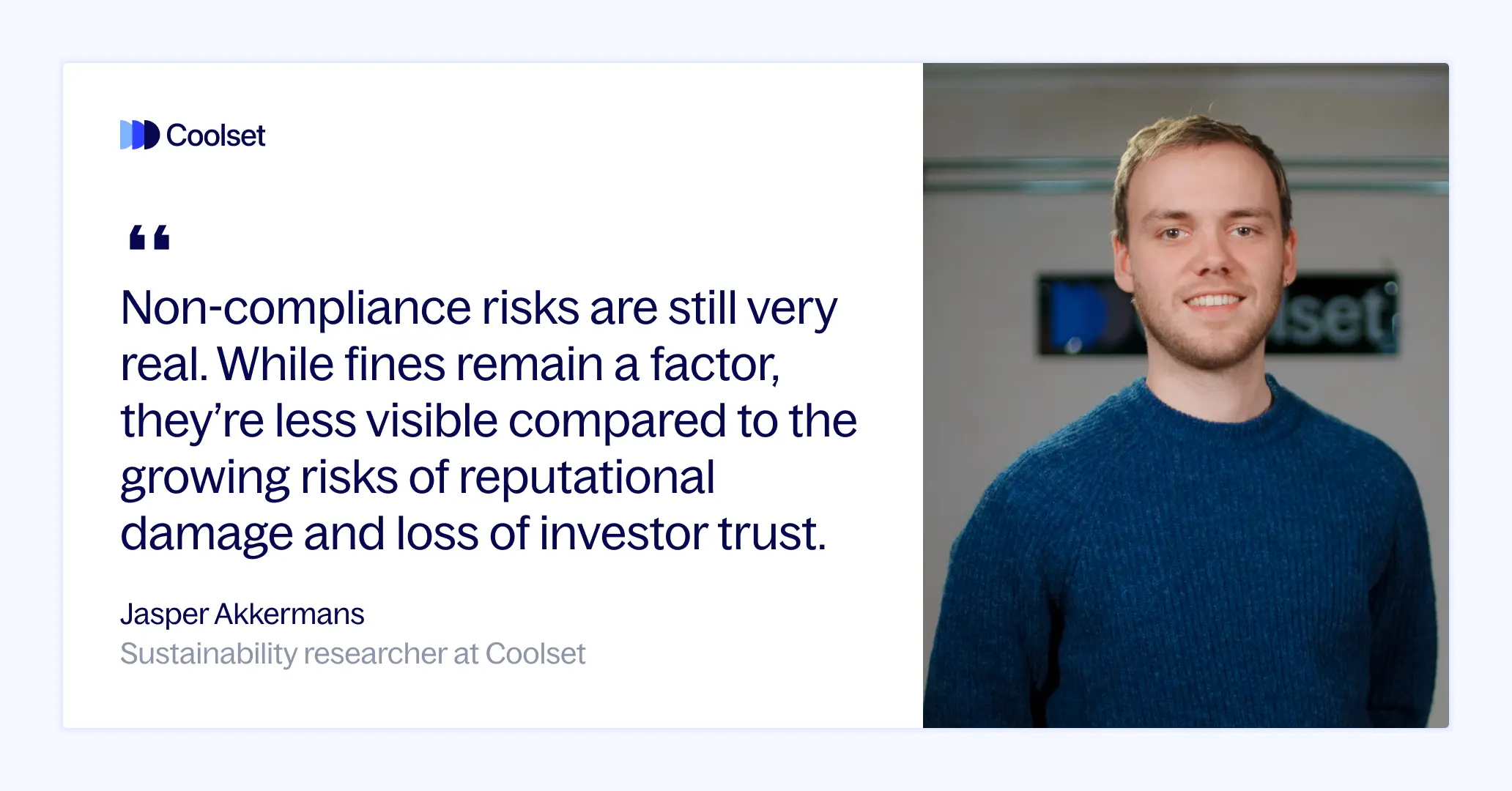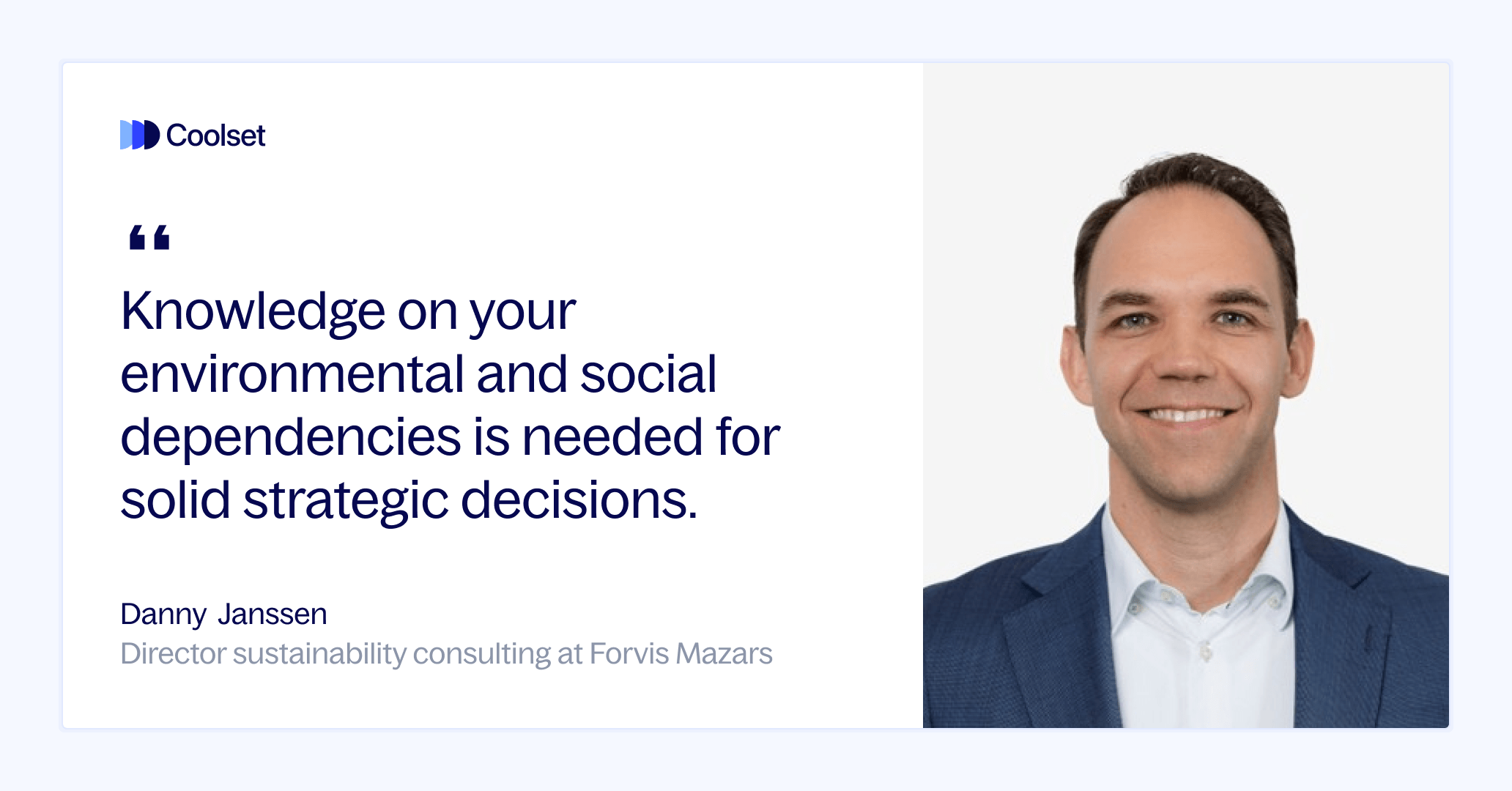
Disclaimer: Latest EUDR developments
On 21 October, the European Commission proposed targeted changes to the EU Deforestation Regulation (EUDR). These adjustments aim to make the rollout smoother without changing the regulation’s overall goals.
Key points from the proposal:
We're closely monitoring the development and will update our content accordingly. In the meantime, read the full explainer here.
Sustainability reporting in 2025 is entering a new phase. What was once treated as a compliance exercise is now becoming a defining factor for business resilience and competitiveness. Shifts in regulation, growing market expectations, and the financial reality of climate risks are forcing companies - especially in Europe’s mid-market segment - to rethink how they manage and disclose ESG information.
While the EU debates the scope of rules like the Corporate Sustainability Reporting Directive (CSRD), investors, customers, and insurers are already raising the bar. At the same time, scientific evidence shows that climate boundaries are being crossed, underscoring the urgency for businesses to act.
This article draws on insights from a recent joint webinar hosted by Coolset and Forvis Mazars, combining technology and advisory perspectives. It provides a structured overview of the three forces shaping ESG reporting today - regulations, markets, and climate risks - and what they mean for companies building long-term sustainability strategies.
In 2025, the regulatory environment for sustainability reporting is both expanding and shifting. The CSRD is officially in effect, bringing tens of thousands of European companies into mandatory sustainability disclosure for the first time. At the same time, many countries outside the EU are adopting the International Sustainability Standards Board (ISSB) framework, signaling a global move toward common sustainability reporting standards.
Policymakers in Europe have introduced the Omnibus proposal, designed to recalibrate ESG reporting requirements. If enacted, the changes would:
Across the Atlantic, the U.S. Securities and Exchange Commission (SEC) is delaying its climate disclosure rule amid political and legal disputes, adding to the perception of regulatory slowdowns.

Despite these shifts, businesses are moving forward. The PwC Global Sustainability Reporting Survey 2025 shows a split response:
This resilience reflects a broader recognition: regulation sets the baseline, but it’s not the only driver. Staying on track prepares companies for future tightening of rules and avoids reputational risks linked to non-compliance. In fact, assurance of ESG data - limited at first - is already expected, and those who invest early in reporting capabilities will be ready when stricter standards arrive.
Even with timelines shifting, the regulatory direction is clear: disclosure requirements are becoming stricter and broader. Companies should prioritize:
Regulation has already changed ESG reporting from a niche practice to a mainstream business responsibility. The smartest companies treat compliance as the minimum - and use reporting as a tool to build resilience, trust, and competitiveness.
While regulation sets the baseline, market pressure is often the stronger force behind sustainability reporting. Investors, lenders, customers, and employees increasingly expect reliable ESG information to guide their decisions - and this demand is only intensifying.
As can be seen in the survey results in the section above, most companies are already dedicating more resources and leadership attention to sustainability reporting - and the majority are finding real business value in the process. This shift goes beyond compliance. It shows that stakeholders now expect sustainability data as part of standard business information.
Investors use ESG performance as a proxy for long-term resilience, customers are embedding it into supplier criteria, and employees increasingly judge employers on it. The same momentum reflected in the survey is also reshaping what markets demand, turning transparency into a baseline expectation rather than a differentiator.

Institutional investors and banks now treat ESG metrics as part of financial risk management. Nearly 80% of global investors factor environmental and climate data into their investment decisions. Companies with credible disclosures can access capital more easily, sometimes even at better rates. Those without may face higher financing costs or fewer opportunities.
Large corporates are cascading ESG requirements onto their suppliers, and the pressure is accelerating. Major multinational buyers often require suppliers to disclose sustainability data to remain eligible for contracts.
Meanwhile, in broader markets, virtually all S&P 500 companies (98.6%) in 2023 published ESG reports, up from just 20% a decade ago. This statistic illustrates how investor expectations have turned non-financial reporting into standard business practice.
Looking ahead, a 2025 Bain & Company survey shows that by 2028, half of B2B buyers plan to drop suppliers that can’t meet sustainability criteria. Already, 49% of corporate buyers are reallocating spend toward more sustainable partners and away from those with weak ESG performance.
For mid-market firms, these trends mean that providing credible ESG data about carbon footprints, labor practices, or supply chain risks is becoming a prerequisite for doing business. Companies that can’t keep up may lose deals, even if they pass technical compliance thresholds.
Public expectations matter too. Around 80% of consumers remain concerned about sustainability and prefer responsible brands. Employees - especially younger talent - are drawn to companies with clear ESG commitments, viewing them as safer long-term employers.
Companies that embrace ESG reporting are discovering operational and strategic benefits. Collecting sustainability data often reveals inefficiencies, strengthens supply chain resilience, and sparks product innovation. Transparency builds trust and can open new markets.
To meet these demands, companies are scaling up:
Takeaway for businesses: Market forces are making ESG reporting non-negotiable. Mid-market companies that treat transparency as an opportunity - not just an obligation - will gain access to capital, win supply chain contracts, and strengthen stakeholder trust.
If regulations set the baseline and markets accelerate adoption, climate risk defines the urgency. Climate change is no longer an abstract environmental issue - it is a direct business risk, shaping boardroom decisions and financial disclosures.
In 2025, the Potsdam Institute’s Planetary Boundaries Science Lab reported that 7 of 9 critical Earth system boundaries have been breached, up from six previously. Climate change is among the breached boundaries, alongside biosphere integrity and freshwater use - all showing worsening trends. More than three-quarters of Earth’s vital systems are now under acute stress. The message is clear: businesses cannot treat climate-related risks as distant concerns; they are here, and they are intensifying.

For companies, climate risk is translating directly into financial statements. Physical climate impacts - heatwaves, droughts, floods - have damaged agriculture, disrupted supply chains, and increased infrastructure downtime across Europe. Globally, the first half of 2025 saw an estimated $162 billion in economic losses from natural catastrophes, continuing an upward trend. Insurers are raising premiums or retreating from high-risk areas, while banks are factoring climate scenarios into lending decisions. Ignoring climate risk now means facing higher operating costs, higher financing costs, and greater vulnerability.
In the Netherlands, climate-related impacts and costs are already material. Dutch industry is responsible for approximately €7 billion annually in climate and health damages, according to a study that monetized the external costs of emissions (air pollution, health impacts, etc.).
Furthermore, the Dutch financial sector is itself exposed: in a recent technical assessment, the IMF’s Netherlands: Financial Sector Assessment noted that the Dutch banking system faces both physical flood risk and transition risk - particularly in lending to firms in high-emission sectors.
These national examples show that climate risk is not a distant threat. It is already affecting operating costs, reputational risk, and financial exposure for companies in the Netherlands.
Physical risks are only part of the story. Transition risks - regulatory changes, carbon pricing, technological disruption, and shifting consumer preferences - can be just as destabilizing. Companies without credible transition plans risk stranded assets and shrinking markets. That’s why ESG reporting frameworks like the Task Force on Climate-related Financial Disclosures (TCFD) and the ISSB’s IFRS S2 climate standard place heavy emphasis on transition planning. Investors now expect interim net-zero targets, board-level oversight, and transparent governance of climate risk.
Climate risk has become a central narrative for ESG reporting because it highlights business resilience. Measuring carbon footprints is not just about compliance - it is about understanding long-term viability. As Johan Rockström of the Potsdam Institute put it, humanity is “pushing beyond the limits of a safe operating space, increasing the risk of destabilising the planet.” For businesses, reporting is how they demonstrate accountability: disclosing how they will decarbonize, use resources more efficiently, and adapt to an uncertain climate future.
Climate-related risks have moved into the C-suite agenda. They require companies to:
In short, climate risk ensures ESG reporting is not just about investor relations - it is about preparing for the defining business challenge of our time.
For Europe’s mid-market companies, the evolving ESG reporting landscape brings both challenges and opportunities.
Preparing sustainability reports is resource-intensive, especially for firms doing it for the first time. Collecting reliable data on carbon emissions, energy use, workforce diversity, or supply chain practices often means:
Budgets are under pressure: ESG software spending has risen by about 25% between 2022 and 2025, a steep climb for mid-sized firms with tighter resources. And reporting isn’t a one-off project. Under CSRD, disclosures become an annual cycle of data collection, limited assurance (external audit), and continuous improvement - demanding collaboration between finance, HR, compliance, and operations.
Despite the costs, there are clear business benefits. Companies that invest in reporting capabilities often uncover efficiencies - such as energy savings, waste reduction, and better asset protection against extreme weather. Studies continue to show that firms with robust ESG practices enjoy higher profitability and stronger risk management outcomes.
For mid-market firms, the rewards are tangible:
In short, building ESG capacity is not only about compliance. It can enhance productivity, innovation, and competitiveness.
The upfront costs are real. Consulting and audit fees, investments in new systems, and even capital expenditures (such as installing emissions sensors) can put pressure on profitability. But many firms are starting to treat ESG reporting like IT or quality management - an integrated part of doing business. Encouragingly, over 60% of companies globally say they have already increased resources and management time for sustainability reporting, reflecting its role as a core business function rather than a side project.
The regulatory landscape continues to evolve, particularly with the EU’s Omnibus adjustments. Mid-market firms should monitor whether they fall into CSRD scope now or in future iterations. Even those below the threshold face indirect pressure through supply chains or investors.
One pragmatic step is to start with voluntary reporting under simplified frameworks. The EU’s VSME standard, for example, offers a lighter alternative for companies with fewer than 1,000 employees. Using such frameworks allows mid-market firms to build capacity and credibility before they are formally required to report.
Mid-market businesses that see ESG metrics as key performance indicators of business health - not just compliance costs - are better positioned to thrive. The companies moving early are already finding that sustainability reporting drives sharper decision-making, stronger market access, and resilience in a changing regulatory and climate landscape.
The evolution of ESG reporting is far from over. If anything, 2025 may be remembered as the inflection point when sustainability disclosure truly became business-as-usual. Companies that internalize the three drivers - regulation, market forces, and climate risk - will be best positioned to thrive in the coming years.
This is where partnerships matter. Coolset and Forvis Mazars bring complementary strengths to help mid-market companies navigate this landscape with confidence. Coolset provides the technology and data systems to measure, manage, and report ESG metrics efficiently. Forvis Mazars brings the advisory expertise to ensure reporting is compliant, credible, and aligned with broader strategy and assurance requirements. Together, we help businesses treat ESG not as a burden but as a driver of competitiveness and resilience.
ESG reporting is shifting from a peripheral concern to a central pillar of corporate accountability. Regulations provide the foundation, market forces raise the stakes, and climate science injects urgency. For mid-market firms in Europe and beyond, embracing this shift is no longer optional - it’s a prerequisite for long-term success.
By working together, Coolset and Forvis Mazars help companies turn sustainability reporting into a strategic opportunity: unlocking value, reducing risk, and strengthening credibility in a business environment that increasingly rewards transparency.
Sources:
ESG Today. (2025). Court orders SEC to either defend, change or repeal climate reporting rules. ESG Today.
PwC. (2025). Global Sustainability Reporting Survey 2025: From insight to value — The sustainability reporting journey continues. PwC.
Bain & Company. (2025). The Visionary CEO’s Guide to Sustainability 2025. Bain & Company.
Coolset. (2025). ESG reporting after omnibus. Coolset (Coolset Academy).
Nature & Environment / CE Delft. (2025). Dutch industry annually causes around €7 billion in climate and health damage: study. NL Times (reporting).
Hosted together with Forvis Mazars
